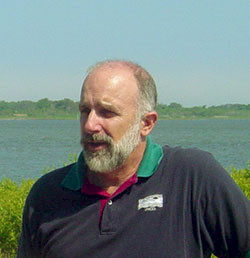Discussion following Bill Dennison's seminar on Challenges and advantages of using citizen scientists for environmental monitoring
Bill Dennison ·
This blog post discusses the seminar given by Bill Dennison of the Integration and Application Network, at the IAN Seminar Series on July 27, 2010.
The use of smart phones by citizen scientists to access the eco-hub portal was discussed and the issue of a) lack of coverage and b) limited availability to some citizen scientists was raised. While technological advances will continue to make both of these issues less profound, they are important considerations. The concept that the smart phone application was only one of several ways to have citizen scientists interact with training materials, data downloads and uploads, and data visualizations. Internet access as well as in person training sessions and data transfers provide alternative mechanisms for interaction between citizen scientists and the eco-hub portal. One of the waterkeepers provided an example of a senior citizen scientist who resigned from the program citing lack of internet and email access, professing to never make the transition to electronic media. However, this individual gained internet access and rejoined the group-so 'never say never' for smart phones was the lesson we gained from this example.
The development and maintenance of a eco-hub portal was discussed. The Waterkeeper Alliance has not offered to host such a portal, and the waterkeepers/riverkeepers preferred that an independent third party be responsible for this portal for the following reasons: a) unbiased, b) appropriate skill sets, c) credibility. To date, the lack of success when the EcoCheck group has submitted grant applications to the Chesapeake Bay Program and NOAA to support this activity has been an impediment.
Environmental literacy was a topic of discussion, based on the Chesapeake Bay literacy slide. The concept of developing environmental literacy principles for each waterway was endorsed and several topics were suggested for each region:
1) Geographic context; location, watershed size and dimensions, connectivity to major bodies of water, proximity of major geomorphic and anthropogenic features
2) Cultural/historic context; indigenous peoples, early European settlement, ethnic groups, historically significant sites
3) Major pollution sources; land use patterns, point and diffuse nutrient sources, current and legacy industrial sources
4) Access and vantage points; boat launch ramps, parks, trails or roadside vantage points, water trails, campsites
5) Significant living resources; location and amount of oyster bars, aquatic grass meadows, salt marshes, sandy or muddy intertidal or subtidal flats, iconic fish or shellfish
6) Ecosystem health; grades or scores from report cards, geographical patterns of indicators, temporal progression (getting better or worse?)
7) Waterway engagement; names of groups involved in the waterway, understanding of the issues and approaches of different groups, how to get more information or join groups
Another topic was that of common urban or rural myths associated with each waterway. The example of more jellyfish (sea nettles) being associated with more pollution was given-this statement does not have any scientific basis, yet is often stated by citizens. The idea that was borne of this discussion was that a good way to inform people is to collect and state common myths and then provide a reasoned and scientifically accurate response.
The development of online training materials was a need expressed by the waterkeeper/riverkeepers. Training videos that could be viewed repeatedly, as well as written versions in a 'cookbook' format would be of great value to citizen scientists. Another feature that was discussed was the development of online quizzes associated with the training materials so that the citizen scientists and the waterkeepers/riverkeepers would have some feedback. The possibility of issuing a certification, perhaps in a multi-level fashion was discussed.
The use of Wikipedia to collect important contextual facts about each waterway was suggested to help develop environmental literacy. The Maryland Department of Natural Resources and the Chesapeake Bay Program used to have concise fact sheets about each waterway posted on their respective websites but no longer support them (and did not update them).
Since this was the first MTAC seminar, a discussion of future topics was raised. One of the ideas was to have each riverkeeper/waterkeeper present a short overview of their waterway and overall activities. Another set of talks to be included are topics of general interest to each group (e.g., bacteria, fisheries, Chesapeake history).
About the author
Bill Dennison

Dr. Bill Dennison is a Professor of Marine Science and Vice President for Science Application at the University of Maryland Center for Environmental Science.